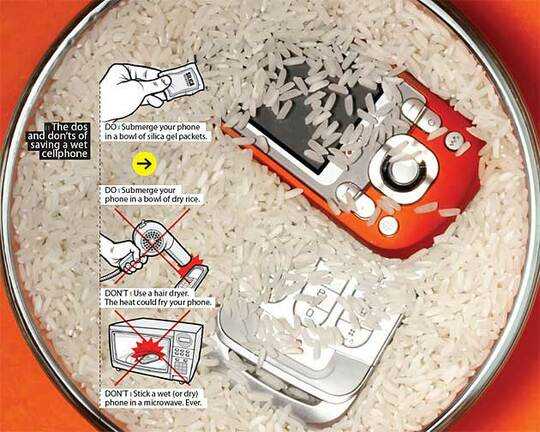The first step: Immediately cut the power by removing the battery. I know it's tempting, but resist the urge to power up your phone to see if it works--just turning it on can short out the circuits. If you have a GSM phone (the type used by AT&T and T-Mobile), you'll want to remove the SIM card as well. Even if your phone turns out to be beyond repair, the SIM should retain a lot of its onboard information, such as the contacts in your phone book.
With the battery safely set aside, you now have one goal--dry your phone, and dry it fast. If you let the moisture evaporate naturally, the chance of corrosion damaging the phone's innards increases. Instead, blow or suck the water out. But don't use a hair dryer--its heat can fry your phone's insides. Instead, opt for a can of compressed air, an air compressor set to a low psi or a vacuum cleaner (a wet/dry Shop-Vac would be perfect). The idea is to use air to push or pull moisture out through the same channels it entered.
Finally, use a desiccant to wick away any leftover moisture. The most convenient choice is uncooked rice. Just leave the phone (and its disconnected battery) submerged in a bowl of grains overnight. If you're worried about rice dust getting inside your phone, you can instead use the packets of silica gel that often come stuffed in the pockets of new clothes. But acting fast is far more important than avoiding a little dust, so don't waste time shopping if you don't already have a drawer full of silica gel.
The most important thing to remember is to avoid heat. That means no hair dryers, ovens, microwaves or extended periods in direct sunlight. While heat will certainly evaporate the moisture, it could also warp components and melt adhesives. Those fragile glues are also why you'll want to avoid dunking the phone in rubbing alcohol (an oftÂprescribed tip on the Web). Alcohol is a solvent and can dissolve the internal adhesives. (If you drop your phone in the toilet, it's okay to wipe the outside with alcohol to disinfect it.)
One final, perhaps surprising, note: If your phone gets soaked in salt water, you should probably flush the whole thing in fresh water before it dries. When salt water evaporates, it leaves crystals that can damage a phone's fragile components. Just be sure to remove the battery before flooding the device.


I had on in the pocket of my jeans go through the wash and dryer, twice. A year later, it's still working without a problem. – Jeff Reddy – 2016-01-22T17:54:20.150
5I've done this so many times and every time the data was gone :( – surfasb – 2011-12-28T22:14:22.377
71The Drive survived just fine, and was very clean made me laugh. – Daniel Beck – 2011-12-28T22:21:20.880
8@surfasb: That's too bad - I've put drives through the wash so many times I've lost count, and have yet to ever lose data from it. – BlueRaja - Danny Pflughoeft – 2011-12-29T00:15:40.773
My buddy put his USB drive through the washer once, and a second time through both the washer and dryer. I haven't asked him recently about whether it is still working but the data was all there after both times and for months after (at least--like I said, I haven't asked him recently) it was fine. – Kazark – 2011-12-29T03:59:34.840
9I have done this at least 3-5 times, each time going through washer and dryer. No data loss or noticeable failure. I'm sure premature corrosion may occur, but for now, things are still good. As with all data, backup. . . backup. . . BACKUP! – Mike Munroe – 2011-12-29T05:02:06.057
18Out of curiosity: What temperature do you need to kill all viruses? Happy new year! – Krumelur – 2011-12-29T09:36:38.703
3OMG...would you mind sharing pen drive brand you guys use ? My Transcent stopped working after a single wash... :O LOL – Sangram – 2011-12-29T11:21:48.467
I washed a Kingstone pendrive 4 years ago. Today It's working without issues. Of course... this is only one case, and there's a huge risk of loss all the data. Make a backup now, before some parts of the device starts getting corroed. – Jonathan – 2011-12-29T11:15:32.410
I experienced a Kingstone pendrive surviving a Finnish winter under a thick layer of snow, with no loss or damage. – Niels – 2011-12-29T14:05:50.813
@Niels: Maybe it was the same model! :D This is my pendrive model -> http://asica1.com/images/8369277_ra.jpg
– Jonathan – 2011-12-29T17:11:23.700I'd probably re-wash it in pure ethanol or isopropyl alcohol to dilute the remaining water, then wait for it to evaporate. – avakar – 2011-12-30T10:49:31.420
@Sangram: this was a Kingston Data Traveler drive... looks like Kingston is the way to go if you are prone to washing them... – None – 2011-12-30T17:12:27.207
1
"Beachcomber finds camera memory card washed up on shore after four years at sea... and now wants to know who's in the photos" http://www.dailymail.co.uk/news/article-2006083/Man-finds-camera-lost-sea-4-years-washed-California-shore.html
– Aki – 2012-01-03T18:21:53.053